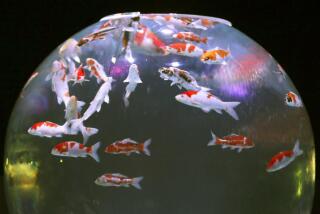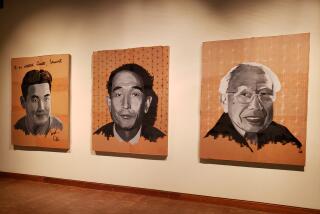Living Jewels
- Share via
Japanese concepts sometimes translate into English in funny ways, with the result that (in my experience at least) a conversation between an American and a Japanese often begins with the Japanese trying to get the American to realize that the American doesn’t understand. One aspect of their complicated culture has to do with the keeping and breeding of koi, or ornamental carp.
As near as I can gather, this is an artistic discipline; the name koi means “living jewel.” Breeders look for a myriad of perfections of shape and symmetry or asymmetry of pattern and color. The very serious breeders are keenly conscious of an ancient complex of the philosophical and artistic meanings of the patterns besides, but I am still too bewildered by my glimpse into this world to say more than this. What matters most about koi to most koi keepers is the patterns they make in the pond. So, as one pond keeper in Santa Barbara told me, even though you can never know how many koi you have at a given moment, if you are properly attentive, you can tell, even out of the corner of your eye, that one of your fish is gone by the changes in the patterns. Standing at the edge of his koi pond, I found this easy to believe.
That pond used to house an ogohn (solid-colored) koi named Von Hindenburg, whose death revised a work of art--that is to say, the patterns in his pond. His name, all by itself, wasn’t that interesting. It was the fact that he had a name that intrigued me, for he belonged, not to the man in Santa Barbara, but to the man’s pond. It seems if there is a belonging of koi, it is to their ponds rather than to a person. (And the ponds can be extraordinarily difficult to set up, since they must be not only beautiful but also safe from raccoons and greater blue herons, who tend to regard koi as lunch, not art.) What was different about Von Hindenburg was that he was the only koi in that pond who would eat out of a person’s hand. Though this is not unusual of koi, it was unusual in that pond. When Von Hindenburg came up for a treat, his fellow koi would follow--so he was the focal point of the ever-changing work of art, the leading element of the design, so to speak.
I am hopelessly American and, having learned that baby koi must be culled carefully, was intrigued that some koi keepers fail to cull their koi seriously. In culling them, the most beautiful survive in all cases where human judgment replaces the culling activities of raccoons and greater blue herons. Nonetheless, I found myself interested by one casual Southern California koi breeder who couldn’t keep his mind on this sort of thing. There was a young fish that failed to display any of the proper, traditional beauties. Also, he swam at a funny kind of tilt. His owners, instead of culling him, named him Robert Geometry, which was the nickname given to a friend of theirs who was always studying branches of geometry in which the symmetries elude the mathematician at every turn.
Robert Geometry didn’t survive very long anyway, thus possibly affirming the wisdom of culling. I still can’t figure out how it is that, even though you cannot count your koi, you can name them. But I learned, standing at the edge of a beautiful pond and at the edge of an ineluctable mystery, talking quietly of koi, that you can name a fish, or a tree--or a human being--even though it is literally countless and unaccountable.
How American--or how interesting--to love the one that doesn’t fit in and so requires a name.


